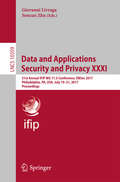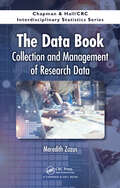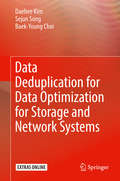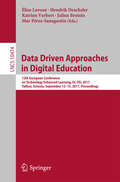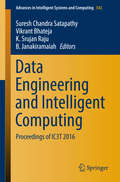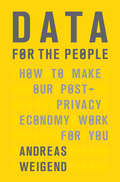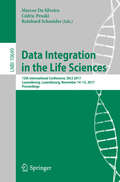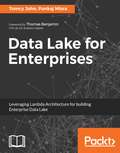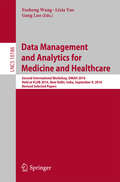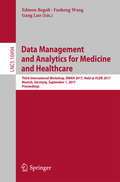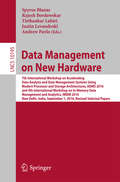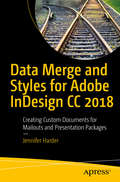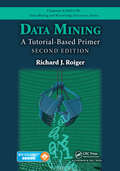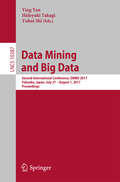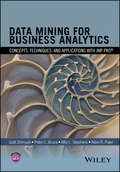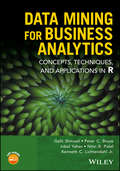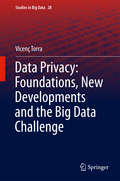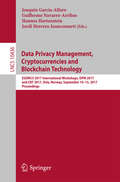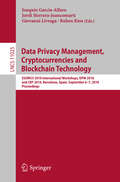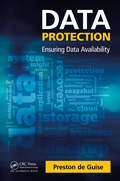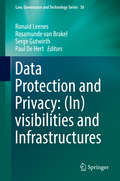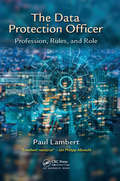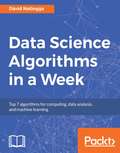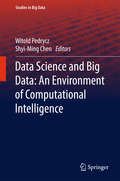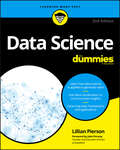- Table View
- List View
Data and Applications Security and Privacy XXXI: 31st Annual IFIP WG 11.3 Conference, DBSec 2017, Philadelphia, PA, USA, July 19-21, 2017, Proceedings (Lecture Notes in Computer Science #10359)
by Giovanni Livraga and Sencun ZhuThis book constitutes the refereed proceedings of the 31st Annual IFIP WG 11.3 International Working Conference on Data and Applications Security and Privacy, DBSec 2017, held in Philadelphia, PA, USA, in July 2017.The 21 full papers and 9 short papers presented were carefully reviewed and selected from 59 submissions. The papers are organized in topical sections on access control, privacy, cloud security, secure storage in the cloud, secure systems, and security in networks and Web.
The Data Book: Collection and Management of Research Data (Chapman & Hall/CRC Interdisciplinary Statistics)
by Meredith ZozusThe Data Book: Collection and Management of Research Data is the first practical book written for researchers and research team members covering how to collect and manage data for research. The book covers basic types of data and fundamentals of how data grow, move and change over time. Focusing on pre-publication data collection and handling, the text illustrates use of these key concepts to match data collection and management methods to a particular study, in essence, making good decisions about data. The first section of the book defines data, introduces fundamental types of data that bear on methodology to collect and manage them, and covers data management planning and research reproducibility. The second section covers basic principles of and options for data collection and processing emphasizing error resistance and traceability. The third section focuses on managing the data collection and processing stages of research such that quality is consistent and ultimately capable of supporting conclusions drawn from data. The final section of the book covers principles of data security, sharing, and archival. This book will help graduate students and researchers systematically identify and implement appropriate data collection and handling methods.
Data Deduplication for Data Optimization for Storage and Network Systems
by Baek-Young Choi Sejun Song Daehee KimThis book introduces fundamentals and trade-offs of data de-duplication techniques. It describes novel emerging de-duplication techniques that remove duplicate data both in storage and network in an efficient and effective manner. It explains places where duplicate data are originated, and provides solutions that remove the duplicate data. It classifies existing de-duplication techniques depending on size of unit data to be compared, the place of de-duplication, and the time of de-duplication. Chapter 3 considers redundancies in email servers and a de-duplication technique to increase reduction performance with low overhead by switching chunk-based de-duplication and file-based de-duplication. Chapter 4 develops a de-duplication technique applied for cloud-storage service where unit data to be compared are not physical-format but logical structured-format, reducing processing time efficiently. Chapter 5 displays a network de-duplication where redundant data packets sent by clients are encoded (shrunk to small-sized payload) and decoded (restored to original size payload) in routers or switches on the way to remote servers through network. Chapter 6 introduces a mobile de-duplication technique with image (JPEG) or video (MPEG) considering performance and overhead of encryption algorithm for security on mobile device.
Data Driven Approaches in Digital Education: 12th European Conference on Technology Enhanced Learning, EC-TEL 2017, Tallinn, Estonia, September 12–15, 2017, Proceedings (Lecture Notes in Computer Science #10474)
by Katrien Verbert Hendrik Drachsler Élise Lavoué Mar Pérez-Sanagustín Julien BroisinThis book constitutes the proceedings of the 12th European Conference on Technology Enhanced Learning, EC-TEL 2017, held in Tallinn, Estonia, in September 2017. The 24 full papers, 23 short papers, 6 demo papers, and 22 poster papers presented in this volume were carefully reviewed and selected from 141 submissions. The theme for the 12th EC-TEL conference on Data Driven Approaches in Digital Education' aims to explore the multidisciplinary approaches that eectively illustrate how data-driven education combined with digital education systems can look like and what are the empirical evidences for the use of datadriven tools in educational practices.
Data Engineering and Intelligent Computing: Proceedings of IC3T 2016 (Advances in Intelligent Systems and Computing #542)
by Suresh Chandra Satapathy Vikrant Bhateja K. Srujan Raju B. JanakiramaiahThe book is a compilation of high-quality scientific papers presented at the 3rd International Conference on Computer & Communication Technologies (IC3T 2016). The individual papers address cutting-edge technologies and applications of soft computing, artificial intelligence and communication. In addition, a variety of further topics are discussed, which include data mining, machine intelligence, fuzzy computing, sensor networks, signal and image processing, human-computer interaction, web intelligence, etc. As such, it offers readers a valuable and unique resource.
Data for the People: How to Make Our Post-Privacy Economy Work for You
by Andreas WeigendA long-time chief data scientist at Amazon shows how open data can make everyone, not just corporations, richerEvery time we Google something, Facebook someone, Uber somewhere, or even just turn on a light, we create data that businesses collect and use to make decisions about us. In many ways this has improved our lives, yet, we as individuals do not benefit from this wealth of data as much as we could. Moreover, whether it is a bank evaluating our credit worthiness, an insurance company determining our risk level, or a potential employer deciding whether we get a job, it is likely that this data will be used against us rather than for us.In Data for the People, Andreas Weigend draws on his years as a consultant for commerce, education, healthcare, travel and finance companies to outline how Big Data can work better for all of us. As of today, how much we benefit from Big Data depends on how closely the interests of big companies align with our own. Too often, outdated standards of control and privacy force us into unfair contracts with data companies, but it doesn't have to be this way. Weigend makes a powerful argument that we need to take control of how our data is used to actually make it work for us. Only then can we the people get back more from Big Data than we give it.Big Data is here to stay. Now is the time to find out how we can be empowered by it.
Data Integration in the Life Sciences: 12th International Conference, DILS 2017, Luxembourg, Luxembourg, November 14-15, 2017, Proceedings (Lecture Notes in Computer Science #10649)
by Marcos Da Silveira Cédric Pruski Reinhard SchneiderThis book constitutes the proceedings of the 12th International Conference on Data Integration in the Life Sciences, DILS 2017, held in Luxembourg, in November 2017. The 5 full papers and 5 short papers presented in this volume were carefully reviewed and selected from 16 submissions. They cover topics such as: life science data modelling; analysing, indexing, and querying life sciences datasets; annotating, matching, and sharing life sciences datasets; privacy and provenance of life sciences datasets.
Data Lake for Enterprises
by Tomcy John Pankaj MisraA practical guide to implementing your enterprise data lake using Lambda Architecture as the base About This Book • Build a full-fledged data lake for your organization with popular big data technologies using the Lambda architecture as the base • Delve into the big data technologies required to meet modern day business strategies • A highly practical guide to implementing enterprise data lakes with lots of examples and real-world use-cases Who This Book Is For Java developers and architects who would like to implement a data lake for their enterprise will find this book useful. If you want to get hands-on experience with the Lambda Architecture and big data technologies by implementing a practical solution using these technologies, this book will also help you. What You Will Learn • Build an enterprise-level data lake using the relevant big data technologies • Understand the core of the Lambda architecture and how to apply it in an enterprise • Learn the technical details around Sqoop and its functionalities • Integrate Kafka with Hadoop components to acquire enterprise data • Use flume with streaming technologies for stream-based processing • Understand stream- based processing with reference to Apache Spark Streaming • Incorporate Hadoop components and know the advantages they provide for enterprise data lakes • Build fast, streaming, and high-performance applications using ElasticSearch • Make your data ingestion process consistent across various data formats with configurability • Process your data to derive intelligence using machine learning algorithms In Detail The term "Data Lake" has recently emerged as a prominent term in the big data industry. Data scientists can make use of it in deriving meaningful insights that can be used by businesses to redefine or transform the way they operate. Lambda architecture is also emerging as one of the very eminent patterns in the big data landscape, as it not only helps to derive useful information from historical data but also correlates real-time data to enable business to take critical decisions. This book tries to bring these two important aspects — data lake and lambda architecture—together. This book is divided into three main sections. The first introduces you to the concept of data lakes, the importance of data lakes in enterprises, and getting you up-to-speed with the Lambda architecture. The second section delves into the principal components of building a data lake using the Lambda architecture. It introduces you to popular big data technologies such as Apache Hadoop, Spark, Sqoop, Flume, and ElasticSearch. The third section is a highly practical demonstration of putting it all together, and shows you how an enterprise data lake can be implemented, along with several real-world use-cases. It also shows you how other peripheral components can be added to the lake to make it more efficient. By the end of this book, you will be able to choose the right big data technologies using the lambda architectural patterns to build your enterprise data lake. Style and approach The book takes a pragmatic approach, showing ways to leverage big data technologies and lambda architecture to build an enterprise-level data lake.
Data Management and Analytics for Medicine and Healthcare: Second International Workshop, DMAH 2016, Held at VLDB 2016, New Delhi, India, September 9, 2016, Revised Selected Papers (Lecture Notes in Computer Science #10186)
by Fusheng Wang Gang Luo Lixia YaoThis book constitutes the thoroughly refereed post-conference proceedings of the Second International Workshop on Data Management and Analytics for Medicine and Healthcare, DMAH 2016, in New Delhi, India, in September 2016, held in conjunction with the 42nd International Conference on Very Large Data Bases, VLDB 2016. The 7 revised full papers presented together with 2 invited papers and 3 keynote abstracts were carefully reviewed and selected from 11 initial submissions. The papers are organized in topical sections on knowledge discovery of biomedical data; managing, querying and processing of medical image data; information extraction and data integration for biomedical data; and health information systems.
Data Management and Analytics for Medicine and Healthcare: Third International Workshop, DMAH 2017, Held at VLDB 2017, Munich, Germany, September 1, 2017, Proceedings (Lecture Notes in Computer Science #10494)
by Edmon Begoli, Fusheng Wang and Gang LuoThis book constitutes the thoroughly refereed conference proceedings of the Third International Workshop on Data Management and Analytics for Medicine and Healthcare, DMAH 2017, in Munich, Germany, in September 2017, held in conjunction with the 43rd International Conference on Very Large Data Bases, VLDB 2017. The 9 revised full papers presented together with 2 keynote abstracts were carefully reviewed and selected from 16 initial submissions. The papers are organized in topical sections on data privacy and trustability for electronic health records; biomedical data management and Integration; online mining of Health related data; and clinical data analytics.
Data Management on New Hardware: 7th International Workshop on Accelerating Data Analysis and Data Management Systems Using Modern Processor and Storage Architectures, ADMS 2016 and 4th International Workshop on In-Memory Data Management and Analytics, IMDM 2016, New Delhi, India, September 1, 2016, Revised Selected Papers (Lecture Notes in Computer Science #10195)
by Justin Levandoski Andrew Pavlo Spyros Blanas Rajesh Bordawekar Tirthankar LahiriThis book contains selected papers from the 7th International Workshop on Accelerating Analytics and Data Management Systems Using Modern Processor and Storage Architectures, ADMS 2016, and the 4th International Workshop on In-Memory Data Management and Analytics, IMDM 2016, held in New Dehli, India, in September 2016. The joint Workshops were co-located with VLDB 2016. The 9 papers presented were carefully reviewed and selected from 18 submissions. They investigate opportunities in accelerating analytics/data management systems and workloads (including traditional OLTP, data warehousing/OLAP, ETL streaming/real-time, business analytics, and XML/RDF processing) running memory-only environments, using processors (e. g. commodity and specialized multi-core, GPUs and FPGAs, storage systems (e. g. storage-class memories like SSDs and phase-change memory), and hybrid programming models like CUDA, OpenCL, and Open ACC. The papers also explore the interplay between overall system design, core algorithms, query optimization strategies, programming approaches, performance modeling and evaluation, from the perspective of data management applications.
Data Merge and Styles for Adobe InDesign CC 2018: Creating Custom Documents for Mailouts and Presentation Packages
by Jennifer HarderHarness the power of Adobe InDesign's data merge and style panel. Whether you're creating custom mail-outs or other mail-merge needs, familiarize yourself with this powerful InDesign panel in this in-depth, step-by-step guide. This book shows you how to easily create, edit, and print data merged documents that match specific branding and style guidelines. You'll learn how to combine MS Excel to create a faster workflow and quickly turn your Adobe InDesign CC 2017 files into printer-ready files. In this book, we'll also take a look at how to apply paragraph and character styles to your text and how you can alter formatting using Global Regular Expressions Print (GREPs). With Data Merge and Styles for Adobe InDesign CC 2017 as your guide, you'll see how to save time and money by learning all the peculiarities and powerful features of Adobe InDesign data merge. By the end of this book, you'll be able to streamline your workflow and avoid using MS Word's mail merge and back-and-forth edits. What You'll Learn Create custom print media with text styles using Adobe InDesign CC 2017 Work with GREPs in conjunction with Character and Paragraph Styles to customize data Build a numbering sequence for tickets Create single and multiple data merges Who This Book Is For Students, graphic designers, and corporate administrators who need to create documents for events.
Data Mining: A Tutorial-Based Primer, Second Edition (Chapman & Hall/CRC Data Mining and Knowledge Discovery Series)
by Richard J. Roiger"Dr. Roiger does an excellent job of describing in step by step detail formulae involved in various data mining algorithms, along with illustrations. In addition, his tutorials in Weka software provide excellent grounding for students in comprehending the underpinnings of Machine Learning as applied to Data Mining. The inclusion of?RapidMiner software tutorials and examples in the book is also a definite plus since it is one of the most popular Data Mining software platforms in use today." --Robert Hughes, Golden Gate University, San Francisco, CA, USA Data Mining: A Tutorial-Based Primer, Second Edition provides a comprehensive introduction to data mining with a focus on model building and testing, as well as on interpreting and validating results. The text guides students to understand how data mining can be employed to solve real problems and recognize whether a data mining solution is a feasible alternative for a specific problem. Fundamental data mining strategies, techniques, and evaluation methods are presented and implemented with the help of two well-known software tools. Several new topics have been added to the second edition including an introduction to Big Data and data analytics, ROC curves, Pareto lift charts, methods for handling large-sized, streaming and imbalanced data, support vector machines, and extended coverage of textual data mining. The second edition contains tutorials for attribute selection, dealing with imbalanced data, outlier analysis, time series analysis, mining textual data, and more. The text provides in-depth coverage of RapidMiner Studio and Weka’s Explorer interface. Both software tools are used for stepping students through the tutorials depicting the knowledge discovery process. This allows the reader maximum flexibility for their hands-on data mining experience.
Data Mining and Big Data: Second International Conference, DMBD 2017, Fukuoka, Japan, July 27 – August 1, 2017, Proceedings (Lecture Notes in Computer Science #10387)
by Ying Tan, Hideyuki Takagi and Yuhui ShiThis book constitutes the refereed proceedings of the Second International Conference on Data Mining and Big Data, DMBD 2017, held in Fukuoka, Japan, in July/August 2017. The 53 papers presented in this volume were carefully reviewed and selected from 96 submissions. They were organized in topical sections named: association analysis; clustering; prediction; classification; schedule and sequence analysis; big data; data analysis; data mining; text mining; deep learning; high performance computing; knowledge base and its framework; and fuzzy control.
Data Mining for Business Analytics: Concepts, Techniques, And Applications In Jmp
by Galit Shmueli Peter C. Bruce Nitin R. Patel Mia L. StephensData Mining for Business Analytics: Concepts, Techniques, and Applications with JMP Pro® presents an applied and interactive approach to data mining. Featuring hands-on applications with JMP Pro®, a statistical package from the SAS Institute, the bookuses engaging, real-world examples to build a theoretical and practical understanding of key data mining methods, especially predictive models for classification and prediction. Topics include data visualization, dimension reduction techniques, clustering, linear and logistic regression, classification and regression trees, discriminant analysis, naive Bayes, neural networks, uplift modeling, ensemble models, and time series forecasting. Data Mining for Business Analytics: Concepts, Techniques, and Applications with JMP Pro® also includes: Detailed summaries that supply an outline of key topics at the beginning of each chapter End-of-chapter examples and exercises that allow readers to expand their comprehension of the presented material Data-rich case studies to illustrate various applications of data mining techniques A companion website with over two dozen data sets, exercises and case study solutions, and slides for instructors Data Mining for Business Analytics: Concepts, Techniques, and Applications with JMP Pro® is an excellent textbook for advanced undergraduate and graduate-level courses on data mining, predictive analytics, and business analytics. The book is also a one-of-a-kind resource for data scientists, analysts, researchers, and practitioners working with analytics in the fields of management, finance, marketing, information technology, healthcare, education, and any other data-rich field. Galit Shmueli, PhD, is Distinguished Professor at National Tsing Hua University's Institute of Service Science. She has designed and instructed data mining courses since 2004 at University of Maryland, Statistics.com, Indian School of Business, and National Tsing Hua University, Taiwan. Professor Shmueli is known for her research and teaching in business analytics, with a focus on statistical and data mining methods in information systems and healthcare. She has authored over 70 journal articles, books, textbooks, and book chapters, including Data Mining for Business Analytics: Concepts, Techniques, and Applications in XLMiner®, Third Edition, also published by Wiley. Peter C. Bruce is President and Founder of the Institute for Statistics Education at www.statistics.com He has written multiple journal articles and is the developer of Resampling Stats software. He is the author of Introductory Statistics and Analytics: A Resampling Perspective and co-author of Data Mining for Business Analytics: Concepts, Techniques, and Applications in XLMiner ®, Third Edition, both published by Wiley. Mia Stephens is Academic Ambassador at JMP®, a division of SAS Institute. Prior to joining SAS, she was an adjunct professor of statistics at the University of New Hampshire and a founding member of the North Haven Group LLC, a statistical training and consulting company. She is the co-author of three other books, including Visual Six Sigma: Making Data Analysis Lean, Second Edition, also published by Wiley. Nitin R. Patel, PhD, is Chairman and cofounder of Cytel, Inc., based in Cambridge, Massachusetts. A Fellow of the American Statistical Association, Dr. Patel has also served as a Visiting Professor at the Massachusetts Institute of Technology and at Harvard University. He is a Fellow of the Computer Society of India and was a professor at the Indian Institute of Management, Ahmedabad, for 15 years. He is co-author of Data Mining for Business Analytics: Concepts, Techniques, and Applications in XLMiner®, Third Edition, also published by Wiley.
Data Mining for Business Analytics: Concepts, Techniques, And Applications In R
by Galit Shmueli Peter C. Bruce Nitin R. Patel Inbal Yahav Kenneth C. Lichtendahl Jr.Data Mining for Business Analytics: Concepts, Techniques, and Applications in R presents an applied approach to data mining concepts and methods, using R software for illustration Readers will learn how to implement a variety of popular data mining algorithms in R (a free and open-source software) to tackle business problems and opportunities. This is the fifth version of this successful text, and the first using R. It covers both statistical and machine learning algorithms for prediction, classification, visualization, dimension reduction, recommender systems, clustering, text mining and network analysis. It also includes: • Two new co-authors, Inbal Yahav and Casey Lichtendahl, who bring both expertise teaching business analytics courses using R, and data mining consulting experience in business and government • Updates and new material based on feedback from instructors teaching MBA, undergraduate, diploma and executive courses, and from their students • More than a dozen case studies demonstrating applications for the data mining techniques described • End-of-chapter exercises that help readers gauge and expand their comprehension and competency of the material presented • A companion website with more than two dozen data sets, and instructor materials including exercise solutions, PowerPoint slides, and case solutions Data Mining for Business Analytics: Concepts, Techniques, and Applications in R is an ideal textbook for graduate and upper-undergraduate level courses in data mining, predictive analytics, and business analytics. This new edition is also an excellent reference for analysts, researchers, and practitioners working with quantitative methods in the fields of business, finance, marketing, computer science, and information technology. “ This book has by far the most comprehensive review of business analytics methods that I have ever seen, covering everything from classical approaches such as linear and logistic regression, through to modern methods like neural networks, bagging and boosting, and even much more business specific procedures such as social network analysis and text mining. If not the bible, it is at the least a definitive manual on the subject.” Gareth M. James, University of Southern California and co-author (with Witten, Hastie and Tibshirani) of the best-selling book An Introduction to Statistical Learning, with Applications in R Galit Shmueli, PhD, is Distinguished Professor at National Tsing Hua University’s Institute of Service Science. She has designed and instructed data mining courses since 2004 at University of Maryland, Statistics.com, Indian School of Business, and National Tsing Hua University, Taiwan. Professor Shmueli is known for her research and teaching in business analytics, with a focus on statistical and data mining methods in information systems and healthcare. She has authored over 70 publications including books. Peter C. Bruce is President and Founder of the Institute for Statistics Education at Statistics.com. He has written multiple journal articles and is the developer of Resampling Stats software. He is the author of Introductory Statistics and Analytics: A Resampling Perspective (Wiley) and co-author of Practical Statistics for Data Scientists: 50 Essential Concepts (O’Reilly). Inbal Yahav, PhD, is Professor at the Graduate School of Business Administration at Bar-Ilan University, Israel. She teaches courses in social network analysis, advanced research methods, and software quality assurance. Dr. Yahav received her PhD in Operations Research and Data Mining from the University of Maryland, College Park. Nitin R. Patel, PhD, is Chairman and cofounder of Cytel, Inc., based in Cambridge, Massachusetts. A Fellow of the American St
Data Privacy: Foundations, New Developments and the Big Data Challenge
by Vicenç TorraThis book offers a broad, cohesive overview of the field of data privacy. It discusses, from a technological perspective, the problems and solutions of the three main communities working on data privacy: statistical disclosure control (those with a statistical background), privacy-preserving data mining (those working with data bases and data mining), and privacy-enhancing technologies (those involved in communications and security) communities.Presenting different approaches, the book describes alternative privacy models and disclosure risk measures as well as data protection procedures for respondent, holder and user privacy. It also discusses specific data privacy problems and solutions for readers who need to deal with big data.
Data Privacy Management, Cryptocurrencies and Blockchain Technology: ESORICS 2017 International Workshops, DPM 2017 and CBT 2017, Oslo, Norway, September 14-15, 2017, Proceedings (Lecture Notes in Computer Science #10436)
by Joaquin Garcia-Alfaro Guillermo Navarro-Arribas Jordi Herrera-Joancomartí Hannes HartensteinThis book constitutes the refereed conference proceedings of the 12th International Workshop on Data Privacy Management, DPM 2017, on conjunction with the 22nd European Symposium on Research in computer Security, ESORICS 2017 and the First International Workshop on Cryprocurrencies and Blockchain Technology (CBT 2017) held in Oslo, Norway, in September 2017. The DPM Workshop received 51 submissions from which 16 full papers were selected for presentation. The papers focus on challenging problems such as translation of high-level buiness goals into system level privacy policies, administration of sensitive identifiers, data integration and privacy engineering. From the CBT Workshop six full papers and four short papers out of 27 submissions are included. The selected papers cover aspects of identity management, smart contracts, soft- and hardforks, proof-of-works and proof of stake as well as on network layer aspects and the application of blockchain technology for secure connect event ticketing.
Data Privacy Management, Cryptocurrencies and Blockchain Technology: Esorics 2018 International Workshops, Dpm 2018 And Cbt 2018, Barcelona, Spain, September 6-7, 2018, Proceedings (Lecture Notes in Computer Science #11025)
by Ruben Rios Giovanni Livraga Jordi Herrera-Joancomartí Joaquin Garcia-AlfaroThis book constitutes the refereed conference proceedings of the 2nd International Workshop on Cryprocurrencies and Blockchain Technology, CBT 2018, and the 13thInternational Workshop on Data Privacy Management, DPM 2018, on conjunction with the 23nd European Symposium on Research in Computer Security, ESORICS 2018, held in Barcelona, Spain, in September 2018. From the CBT Workshop 7 full and 8 short papers out of 39 submissions are included. The selected papers cover aspects of identity management, smart contracts, soft- and hardforks, proof-of-works and proof of stake as well as on network layer aspects and the application of blockchain technology for secure connect event ticketing. The DPM Workshop received 36 submissions from which 11 full and 5 short papers were selected for presentation. The papers focus on challenging problems such as translation of high-level buiness goals into system level privacy policies, administration of sensitive identifiers, data integration and privacy engineering.
Data Protection: Ensuring Data Availability
by Preston de GuiseThis is the fundamental truth about data protection: backup is dead. Or rather, backup and recovery, as a standalone topic, no longer has relevance in IT. As a standalone topic, it’s been killed off by seemingly exponential growth in storage and data, by the cloud, and by virtualization. So what is data protection? This book takes a holistic, business-based approach to data protection. It explains how data protection is a mix of proactive and reactive planning, technology and activities that allow for data continuity. It shows how truly effective data protection comes from a holistic approach considering the entire data lifecycle and all required SLAs. Data protection is neither RAID nor is it continuous availability, replication, snapshots or backups—it is all of them, combined in a considered and measured approach to suit the criticality of the data and meet all the requirements of the business. The book also discusses how businesses seeking to creatively leverage their IT investments and to drive through cost optimization are increasingly looking at data protection as a mechanism to achieve those goals. In addition to being a type of insurance policy, data protection is becoming an enabler for new processes around data movement and data processing. This book arms readers with information critical for making decisions on how data can be protected against loss in the cloud, on-premises, or in a mix of the two. It explains the changing face of recovery in a highly virtualized data center and techniques for dealing with big data. Moreover, it presents a model for where data recovery processes can be integrated with IT governance and management in order to achieve the right focus on recoverability across the business.
Data Protection and Privacy: (Law, Governance and Technology Series #36)
by Paul De Hert Serge Gutwirth Ronald Leenes Rosamunde Van BrakelThis book features peer reviewed contributions from across the disciplines on themes relating to protection of data and to privacy protection. The authors explore fundamental and legal questions, investigate case studies and consider concepts and tools such as privacy by design, the risks of surveillance and fostering trust. Readers may trace both technological and legal evolution as chapters examine current developments in ICT such as cloud computing and the Internet of Things. Written during the process of the fundamental revision of revision of EU data protection law (the 1995 Data Protection Directive), this volume is highly topical. Since the European Parliament has adopted the General Data Protection Regulation (Regulation 2016/679), which will apply from 25 May 2018, there are many details to be sorted out. This volume identifies and exemplifies key, contemporary issues. From fundamental rights and offline alternatives, through transparency requirements to health data breaches, the reader is provided with a rich and detailed picture, including some daring approaches to privacy and data protection. The book will inform and inspire all stakeholders. Researchers with an interest in the philosophy of law and philosophy of technology, in computers and society, and in European and International law will all find something of value in this stimulating and engaging work.
The Data Protection Officer: Profession, Rules, and Role
by Paul LambertThe EU's General Data Protection Regulation created the position of corporate Data Protection Officer (DPO), who is empowered to ensure the organization is compliant with all aspects of the new data protection regime. Organizations must now appoint and designate a DPO. The specific definitions and building blocks of the data protection regime are enhanced by the new General Data Protection Regulation and therefore the DPO will be very active in passing the message and requirements of the new data protection regime throughout the organization. This book explains the roles and responsiblies of the DPO, as well as highlights the potential cost of getting data protection wrong.
Data Science Algorithms in a Week
by David NatinggaBuild strong foundation of machine learning algorithms In 7 days. About This Book • Get to know seven algorithms for your data science needs in this concise, insightful guide • Ensure you're confident in the basics by learning when and where to use various data science algorithms • Learn to use machine learning algorithms in a period of just 7 days Who This Book Is For This book is for aspiring data science professionals who are familiar with Python and have a statistics background. It is ideal for developers who are currently implementing one or two data science algorithms and want to learn more to expand their skill set. What You Will Learn • Find out how to classify using Naive Bayes, Decision Trees, and Random Forest to achieve accuracy to solve complex problems • Identify a data science problem correctly and devise an appropriate prediction solution using Regression and Time-series • See how to cluster data using the k-Means algorithm • Get to know how to implement the algorithms efficiently in the Python and R languages In Detail Machine learning applications are highly automated and self-modifying, and they continue to improve over time with minimal human intervention as they learn with more data. To address the complex nature of various real-world data problems, specialized machine learning algorithms have been developed that solve these problems perfectly. Data science helps you gain new knowledge from existing data through algorithmic and statistical analysis. This book will address the problems related to accurate and efficient data classification and prediction. Over the course of 7 days, you will be introduced to seven algorithms, along with exercises that will help you learn different aspects of machine learning. You will see how to pre-cluster your data to optimize and classify it for large datasets. You will then find out how to predict data based on the existing trends in your datasets. This book covers algorithms such as: k-Nearest Neighbors, Naive Bayes, Decision Trees, Random Forest, k-Means, Regression, and Time-series. On completion of the book, you will understand which machine learning algorithm to pick for clustering, classification, or regression and which is best suited for your problem. Style and approach Machine learning applications are highly automated and self-modifying which continue to improve over time with minimal human intervention as they learn with more data. To address the complex nature of various real world data problems, specialized machine learning algorithms have been developed that solve these problems perfectly.
Data Science and Big Data: An Environment of Computational Intelligence (Studies in Big Data #24)
by Witold Pedrycz Shyi-Ming ChenThis book presents a comprehensive and up-to-date treatise of a range of methodological and algorithmic issues. It also discusses implementations and case studies, identifies the best design practices, and assesses data analytics business models and practices in industry, health care, administration and business. Data science and big data go hand in hand and constitute a rapidly growing area of research and have attracted the attention of industry and business alike. The area itself has opened up promising new directions of fundamental and applied research and has led to interesting applications, especially those addressing the immediate need to deal with large repositories of data and building tangible, user-centric models of relationships in data. Data is the lifeblood of today's knowledge-driven economy. Numerous data science models are oriented towards end users and along with the regular requirements for accuracy (which are present in any modeling), come the requirements for ability to process huge and varying data sets as well as robustness, interpretability, and simplicity (transparency). Computational intelligence with its underlying methodologies and tools helps address data analytics needs. The book is of interest to those researchers and practitioners involved in data science, Internet engineering, computational intelligence, management, operations research, and knowledge-based systems.
Data Science For Dummies
by Jake Porway Lillian PiersonYour ticket to breaking into the field of data science! Jobs in data science are projected to outpace the number of people with data science skills—making those with the knowledge to fill a data science position a hot commodity in the coming years. Data Science For Dummies is the perfect starting point for IT professionals and students interested in making sense of an organization's massive data sets and applying their findings to real-world business scenarios. From uncovering rich data sources to managing large amounts of data within hardware and software limitations, ensuring consistency in reporting, merging various data sources, and beyond, you'll develop the know-how you need to effectively interpret data and tell a story that can be understood by anyone in your organization. Provides a background in data science fundamentals and preparing your data for analysis Details different data visualization techniques that can be used to showcase and summarize your data Explains both supervised and unsupervised machine learning, including regression, model validation, and clustering techniques Includes coverage of big data processing tools like MapReduce, Hadoop, Dremel, Storm, and Spark It's a big, big data world out there—let Data Science For Dummies help you harness its power and gain a competitive edge for your organization.
